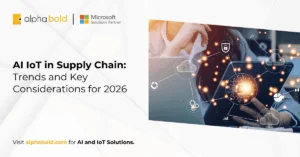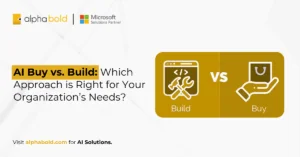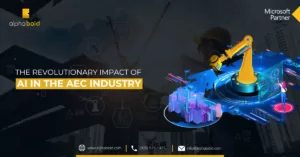Real-Time Manufacturing Insights With GPT-5 On Azure AI Foundry
Table of Contents
A temperature spike hits Line 3 at 9:12 a.m. Sensors push the alert. A shift lead adds two notes in Teams. Within minutes, an AI agent pulls the last 60 days of vibration data, recent work orders, parts on hand, and supplier SLAs. It recommends a bearing swap, updates tomorrow’s production plan to avoid bottlenecks, drafts the supplier message, and produces a short cost-avoidance brief for leadership.
This end-to-end flow is now practical with GPT-5 in Azure AI Foundry, working over real-time signals in Microsoft Fabric. The value for manufacturers is simple. Faster root-cause analysis, decisions that are traceable, and actions that reach the boardroom in the same window of time as the incident. This article shows how that flow works and where to start.
Why This Is Different Now
- GPT-5 is in the Microsoft stack you already use. Microsoft has rolled GPT-5 into Copilot and made it available in Azure AI Foundry, so leaders and builders can use the same model across Microsoft 365, GitHub, and custom apps. Copilot’s new “smart mode” routes tasks to the best model for speed or deeper reasoning.
- Real-time data is first-class in Fabric. Fabric Real-Time Intelligence is generally available and built to ingest events, detect anomalies, and trigger actions with governance across the data estate. It covers ingestion, transformation, modeling, analytics, and real-time actions in one place.
- No-code event streams lower the barrier. Eventstreams in Fabric let teams route shop-floor signals into Eventhouse and downstream systems without code. That reduces the time from signal to analysis and keeps pilots moving.
- There is manufacturing traction, not just hype. Microsoft’s recent manufacturing brief highlights programs with Sandvik, Textron, Husqvarna, Siemens, and Sight Machine as reference points for AI-powered operations. These show how plant-level insights are moving quickly to executive decision packets.
How The Stack Actually Works
Real-time insight starts at the line. Sensor and PLC signals land in Azure IoT and flow into Fabric’s Real-Time Intelligence, where eventstreams catch issues as they happen and route them to alerts or automations. You set anomaly rules and actions quickly, without waiting on a batch job or a custom integration.
Those signals need context. Eventhouse with a KQL database lets you join telemetry with maintenance logs, work orders, and inventory so every alert carries history and availability. You are not just seeing a spike. You are seeing a spike tied to last month’s rebuild, the technician who worked it, and the part that is on the shelf.
This is where GPT-5 earns its keep. Through Azure AI Foundry, an agent pulls governed context from Fabric and produces what teams actually need: a root-cause narrative, a recommended plan, and ready-to-send notes for suppliers and shift leads. The model router selects the right GPT-5 variant, so you get deeper reasoning when it matters and faster responses when it does not.
Close the loop where people already work. Actions and summaries land in Teams, Power BI, and Microsoft 365 Copilot, so a plant incident becomes an executive-ready brief without leaving the Microsoft environment.
Build Your First AI Driven Workflow
Start with one measurable outcome such as downtime avoided or faster reporting and scale across your operations with AlphaBOLD’s manufacturing experts.
Request a ConsultationFrom Alert To Board Brief In One Morning
At 9:12 a.m., a temperature and vibration spike trips an alert on Line 3. The notification lands in Teams, and the shift lead adds two quick notes about a new rattle and a slight speed drop.
Behind the scenes, an agent running on GPT-5 pulls sixty days of telemetry, recent work orders, SOPs, and store inventory. It compares similar incidents, ranks likely causes, and returns a plain-English assessment: bearing wear on the drive motor, medium to high confidence, with a four-hour window before an unplanned stop becomes likely.
Action plan:
- Bearing swap during a 40-minute micro shutdown at shift change
- Exact part number listed and validated
- Two units confirmed in stock
- Technician job plan attached with torque values and safety checks
- Operations reviews and approves in Teams
Protecting shipments:
- Rebalance work to keep today’s ship list intact
- Move a priority SKU to Line 2 for an 11:30 to 13:00 window
- Short note on throughput and labor for supervisor briefings
Supplier follow-up:
- Inventory will be zero after the swap
- Draft email to the bearing supplier requesting two replacements under the current SLA
- Target arrival date included with a preventive-maintenance justification
Executive view:
- By 9:30 a.m., leadership receives a one-page brief in Microsoft 365
- Contents include situation, probable root cause, action taken, expected impact, and residual risk
- A simple table quantifies avoided downtime, preserved shipments, and next maintenance checks
Results you can measure:
- MTTR reduced on targeted incidents
- Unplanned downtime avoided per event
- First-time-fix rate improved on recurring faults
- Time to executive brief cut from days to minutes
- On-time-ship protected during maintenance windows
Why Choose AlphaBOLD
Most manufacturers already have islands of telemetry, SOPs in SharePoint, and Excel-heavy reporting. AlphaBOLD turns that sprawl into a governed, real-time decision loop on Microsoft Fabric and Azure AI Foundry, then lands the experience in tools your teams open every day. We build the streaming backbone, the GPT-5 agent tuned to your assets and workflows, the Copilot surfaces for operators and leaders, and the guardrails for audit and access.
Turn Plant Data Into Real-Time Decisions
AlphaBOLD connects Microsoft Fabric, Azure AI Foundry, and GPT-5 so your teams move from alerts to executive briefs in minutes.
Request a ConsultationGPT-5 provides reasoning and contextual recommendations rather than just raw anomaly alerts. Combined with Fabric’s real-time intelligence, it turns shop-floor signals into actionable workflows and executive-ready reports.
Yes. Most teams begin with one workflow tied to a measurable metric such as avoided downtime, reduced time-to-report, or improved first-time-fix rates. This ensures quick ROI and a clear path to scaling.
Fabric can ingest sensor data, PLC signals, maintenance logs, work orders, and inventory records. Eventstreams and Eventhouse connect these sources with minimal setup, making it easier to unify plant and business data.
Because GPT-5 is embedded across Microsoft 365, Teams, Power BI, and Dynamics 365, manufacturers extend their current environment rather than adopting a separate platform. This reduces adoption risks and speeds up value realization.
Enterprises report lower mean time to repair, fewer unplanned downtime events, faster executive brief cycles, and improved on-time shipment performance. These results demonstrate tangible ROI beyond efficiency gains.
Explore Recent Blog Posts








